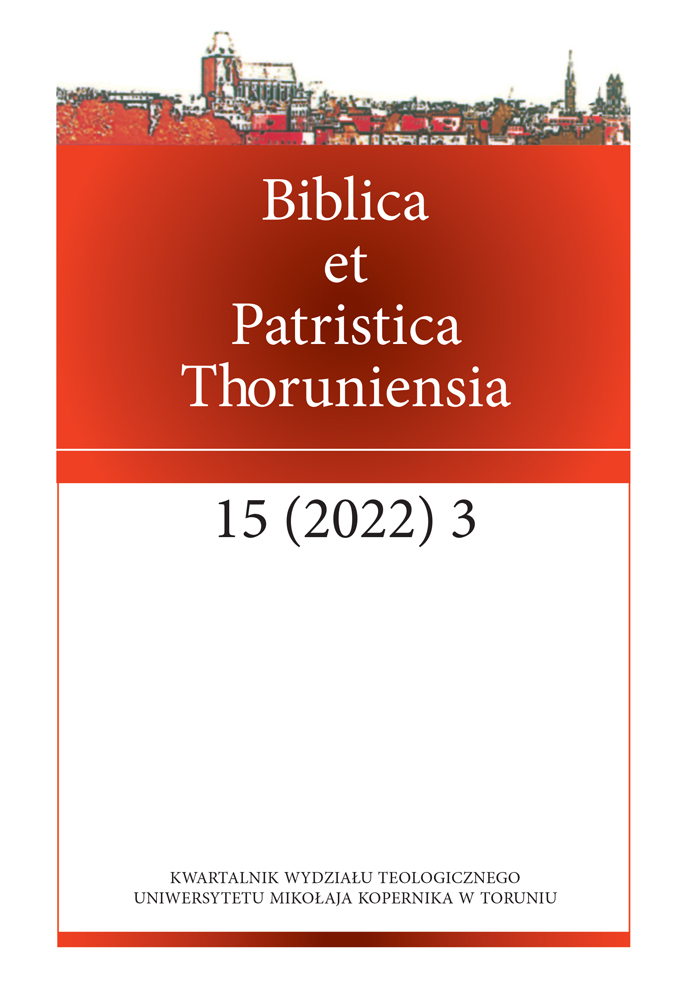„Cała sprawiedliwość” (pasa dikaiosynē) w Mateuszowej narracji o chrzcie Jezusa (3,13–17)
DOI :
https://doi.org/10.12775/BPTh.2022.015Mots-clés
Jan, Jezus, chrzest, cała sprawiedliwość, umiłowany Syn, nowe stworzenie, nowy lud BożyRésumé
Autor artykułu, analizując Mateuszową perykopę o chrzcie Jezusa, a w niej szczególnie jego materiał własny dotyczący dialogu Nazarejczyka z Janem, dochodzi do wniosku, że użyte w niej słowa „cała sprawiedliwość” w narracyjnym i teologicznym zamyśle Ewangelisty pełnią funkcję słów kluczy do zrozumienia nie tylko samej działalności Jana i chrztu Jezusa, lecz także całego orędzia o królestwie niebios w jego Ewangelii. Rzeczownik dikaiosynē rozumie on jako wolę Bożą. Za takim rozumieniem przemawia fakt, że łączy on go z czasownikiem pleroō, za pomocą którego programowo i konsekwentnie dowodzi w całej swej narracji, że w Jezusie wypełniają się wszystkie obietnice Boga. Dodając zaś przymiotnik pasa przesądza, że ma na myśli całą wolę Bożą, czyli tę już objawioną, i tę, która jest objawiana w Dobrej Nowinie o królestwie niebios. Otwarcie niebios przez Boga i Jego głos obwieszcza zmianę dotychczasowych relacji między Nim a ludzkością i światem, w związku z dopełnianiem się całej sprawiedliwości. Fakt, że zostały one otwarte Jezusowi, oznacza, że te nowe relacje zostaną zrealizowane w nowym stworzeniu i nowym ludzie, to jest Kościele wszystkich narodów, przez zbawcze dzieło Jezusa – Dziedzica Ducha Bożego i Sługi Pańskiego, który zbawi ludzkość od jej grzechów i odnowi całe stworzenie. Poza tym, jego narracja o chrzcie służy uwiarygodnieniu słów Jezusa skierowanych do Jana.
Références
Bartnicki, Roman. 2007. „Chrzest Jezusa w Jordanie w perspektywie historiozbawczej (Mk 1,9–11; Mt 3,13–17; Łk 3,21–22; J 1,29–34).” W Verbum caro factum est. Księga pamiątkowa dla Księdza Profesora Tomasza Jelonka w 70. rocznicę urodzin, red. Roman Bogacz, Waldemar Chrostowski, 99–109. Warszawa: Stowarzyszenie Biblistów Polskich.
Davies, William D., and Dale C. Allison. 2004. A critical and exegetical commentary on the Gospel according to saint Matthew. London–New York: Bloomsbury T&T Clark.
France, R.T. 2007. The Gospel of Matthew. Michigan: Eerdmans.
Frankemölle, Hubert. 1994. Matthäus Kommentar, t. 1. Düsseldorf: Patmos-Verlag.
Garland, David E. 2001. Reading Matthew. A literary and theological commentary on the First Gospel. Macon: Smyth & Helwys Publishing, Inc.
Gibbs, Jeffrey A. 2006. A theological exposition of sacred scripture. Matthew 1:1–11:1. Concordia Commentary. Saint Louis: Concordia Publishing.
Gnilka, Joachim. 2000. Das Matthäusevangelium. Herders Theologischer Kommentar zum Neuen Testament. Sonderausgabe. Freiburg–Basel–Wien: Herder.
Howard V., Peabody D.B. 2000. „Ewangelia według św. Marka.” W Międzynarodowy komentarz do Pisma Świętego, red. W.R. Farmer, 1206–1238. Warszawa: Verbinum.
Leska, Adrian. 2000. „Ewangelia według św. Mateusza.” W Międzynarodowy komentarz do Pisma Świętego, red. William R. Farmer, 1133–1205. Warszawa: Verbinum.
Luz, Ulrich. 1992. Das Evangelium nach Matthäus. Evangelisch-Katholischer Kommentar zum Neuen Testament, Bd I/1. Zürich: …
Nestle, Eberhard, and Erwin Nestle, eds. 1998. Novum Testamentum Graece. Stuttgart: Deutsche Bibelgesellschaft.
Malina, Artur. 2007. Chrzest Jezusa w czterech Ewangeliach. Studium narracji i teologii. Studium i Materiały Wydziału Teologicznego Uniwersytetu Śląskiego w Katowicach, nr 34, Katowice: Księgarnia św. Jacka.
Malina, Artur. 2009. „Dlaczego Jezus «zobaczył Ducha Bożego zstępującego jakby gołębica» (Mt 3,16 i par.)?” Verbum Vitae 8 (16): 125–143.
Malina, Artur. 2013. „Ewangelia według św. Marka.” W Nowy komentarz biblijny Nowego Testamentu, red. A. Paciorek, R. Bartnicki, A. Tronina, t. I/1, Częstochowa: Edycja Świętego Pawła.
Quell, Gottfried, Gottlob, Schrenk. 1990. „dikē, dikaios, dikaiosynē, dikaioō…” In Theologisches Wörterbuch zum Neuen Testament, hrsg. von. Gerhard Kittel, Bd. II, 176–228. Stuttgart–Basel–Köln: wbg Academic.
Paciorek, Antoni. 2005. Ewangelia według świętego Mateusza, w: A. Paciorek, R. Bartnicki, A. Tronina (red.), Nowy komentarz biblijny Nowego Testamentu, t. I/1, Częstochowa: Edycja Świętego Pawła.
Popowski, Remigiusz. 1995. Wielki słownik grecko-polski Nowego Testamentu. Warszawa: Wydawnictwo „Vocatio”.
Sand, Alexander. 1986. Das Evangelium nach Matthäus. Kommentar. Regensburg: Verlag Friedrich Pustet.
Ziesler, John. 1999. „Sprawiedliwość.” W Słownik wiedzy biblijnej, red. Bruce M. Metzger, Michael D. Coogan. Warszawa: Wydawnictwo WAM.
Żywica, Zdzisław. 2003. „Mateuszowe formuły i cytaty wypełnienia.” W Pieśniami dla mnie twoje przykazania. Księga pamiątkowa dla Księdza Profesora Janusza Frankowskiego w 50. rocznicę święceń kapłańskich i 75. rocznicę urodzin, red. Waldemar Chrostowski, 470–486. Warszawa: Oficyna Wydawnicza „Vocatio”.
Żywica, Zdzisław. 2006. Kościół Jezusa a judaizm i poganie według Ewangelisty Mateusza. Teologia narratywna. Olsztyn: Wydawnictwo Uniwersytetu Warmińsko-Mazurskiego.
Żywica, Zdzisław. 2021. “Il cammino di Giuseppe verso la giustizia evangelica nell’ottica di Mt 1,18–25.” Forum Teologiczne XXII: 207–222.
Téléchargements
Publiée
Comment citer
Numéro
Rubrique
Licence
© Zdzisław Józef Żywica 2022

Ce travail est disponible sous licence Creative Commons Attribution - Pas de Modification 4.0 International.
CC BY ND 4.0. Posiadaczem prawa autorskiego (Licencjodawcą) jest Autor, który na mocy umowy licencyjnej udziela nieodpłatnie prawa do eksploatacji dzieła na polach wskazanych w umowie.
- Licencjodawca udziela Licencjobiorcy licencji niewyłącznej na korzystanie z Utworu/przedmiotu prawa pokrewnego w następujących polach eksploatacji: a) utrwalanie Utworu/przedmiotu prawa pokrewnego; b) reprodukowanie (zwielokrotnienie) Utworu/przedmiotu prawa pokrewnego drukiem i techniką cyfrową (e-book, audiobook); c) wprowadzania do obrotu egzemplarzy zwielokrotnionego Utworu/przedmiotu prawa pokrewnego; d) wprowadzenie Utworu/przedmiotu prawa pokrewnego do pamięci komputera; e) rozpowszechnianie utworu w wersji elektronicznej w formule open access na licencji Creative Commons (CC BY-ND 3.0) poprzez platformę cyfrową Wydawnictwa Naukowego UMK oraz repozytorium UMK.
- Korzystanie przez Licencjobiorcę z utrwalonego Utworu ww. polach nie jest ograniczone czasowo ilościowo i terytorialnie.
- Licencjodawca udziela Licencjobiorcy licencji do Utworu/przedmiotu prawa pokrewnego nieodpłatnie na czas nieokreślony
PEŁEN TEKST UMOWY LICENCYJNEJ >>
Stats
Number of views and downloads: 569
Number of citations: 0



